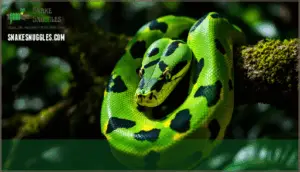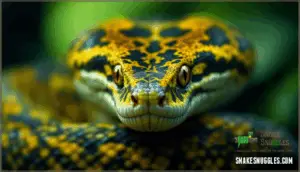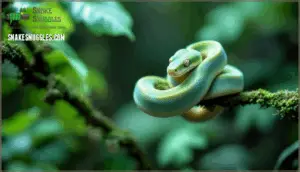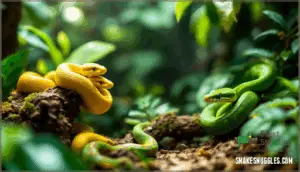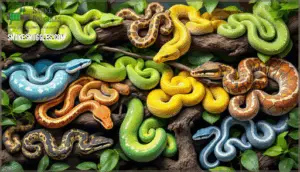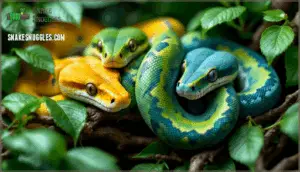This site is supported by our readers. We may earn a commission, at no cost to you, if you purchase through links.
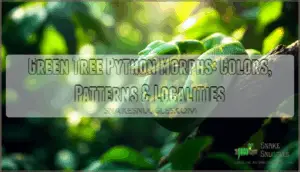 {{
{{
Table Of Contents
- Key Takeaways
- Papuan Highlands Morph
- Sorong Morph
- Origins of Green Tree Python Morphs
- Popularity of Green Tree Python Morphs
- Unique Features of Green Tree Python Morphs
- Frequently Asked Questions (FAQs)
- What are green tree python morphs?
- What is the wrong morph of green tree pythons?
- What is a morph Python?
- Are green tree python morphs a good pet?
- Where can I buy green tree pythons?
- What is a high-blue morph green tree python?
- Can green tree pythons be handled regularly safely?
- How often should I feed my green tree python?
- Can I breed green tree pythons with other python species?
- What diet do green tree pythons need?
- Conclusion
Key Takeaways
- Green Tree Python morphs emerge from geographic isolation across New Guinea, Indonesia, and northern Australia, where ancient population splits created distinct northern and southern lineages with unique genetic foundations that produce dramatically different color patterns—from the bold, high-contrast Papuan Highlands morphs to the delicate pastel hues of Sorong morphs.
- The snakes’ remarkable ontogenetic color change—juveniles shifting from bright yellow or red to vibrant green within their first year—reflects an adaptive survival strategy for camouflage at different life stages, driven by recently identified genetic mutations in TYR and OCA2 genes.
- Popularity among reptile enthusiasts has exploded, with MorphMarket listings jumping 47% globally between 2021 and 2025, though widespread hybridization now complicates efforts to maintain genetically pure locality-specific lines that preserve the natural diversity of these morphs.
- These arboreal specialists require experienced keepers who can meet their exacting care demands—precise humidity and temperature control, specialized enclosure setup for their canopy-dwelling lifestyle, and cautious handling that respects their individual temperaments and stress thresholds.
Papuan Highlands Morph
When you think of the Papuan Highlands morph,
Bold Patterns and Contrasting Colors
If you’ve ever wondered what makes a snake practically leap off its perch with visual intensity, the Papuan Highlands Morph delivers that exact wow factor through its dramatic color intensity and bold patterns.
The Papuan Highlands Morph delivers visual intensity through dramatic color and bold patterns that make the snake practically leap off its perch
These snakes showcase striking contrasting morphs with scale variations that shift as they mature. Their coloration creates stunning breeding outcomes that
Unique Appearance
What really seals the deal with the Papuan Highlands Morph is how its head markings and eye color distinguish it from simply bold to genuinely unforgettable. The eye coloration ranges from golden amber to deep crimson, contrasting beautifully with the body shape and green tree python coloration that defines these stunning morphs.
You’ll notice intricate scale variations that create unexpected texture across the body, while color intensity shifts dramatically between dorsal and ventral surfaces. Pattern development shows striking complexity—think geometric precision meets organic flow.
Sorong Morph
If you’re after something more subtle and dreamlike, the Sorong morph might just steal your heart. These pythons show off delicate, pastel-like hues that give them an almost ethereal quality.
Let’s look at what makes this morph so alluring.
Delicate, Pastel-like Hues
The Sorong morph’s whisper-soft palette transforms what you’d expect from a python into something that belongs more in a watercolor painting than in the wild. These Green Tree Python morphs display delicate pastel-like hues that distinguish them through:
- Pastel color genetics creating butter-yellow and powder-blue color variations
- Rarest pastel morphs showcasing unmatched hue variations in coloration
- Breeding pastel morphs requiring specialized pastel husbandry needs for best development
Ethereal Appearance
{{
Origins of Green Tree Python Morphs
Across New Guinea, Indonesia, and northern Australia, Green Tree Python morphs emerge from a fascinating mix of geography and genetics. The central mountain range of New Guinea splits populations into northern and southern lineages, each with distinct genetic foundations and color patterns. You’ll find southern localities like Aru Islands consistently producing yellow hatchlings, while northern regions yield both yellow and red morphs—sometimes within the same clutch.
This genetic diversity stems from ancient isolation and founder effects that shaped local populations over millennia. Historical importation since the 1990s introduced specimens from various islands into captivity, though hybridization effects now complicate efforts to maintain locality-pure lines.
The ontogenetic color change—juveniles transforming from bright yellow or red to vibrant green within their first year—reflects adaptive significance for camouflage at different life stages. Recent genetic mutations identified in TYR and OCA2 genes help explain this striking diversity you see today. These snakes are non-venomous constrictors, utilizing constriction to subdue their prey.
Popularity of Green Tree Python Morphs
Green tree python morphs have taken the reptile world by storm. What
Skyrocketing Among Reptile Hobbyists and Breeders
You’ll find Green Tree Python morphs have become a phenomenon across reptile breeding circles, with MorphMarket listings jumping 47% globally between 2021 and 2025. Market demand reflects genuine fascination—captive-bred morphs now represent over.
This popularity contributes to the global reptile trade, which can impact wild populations.
Capturing Hearts and Imaginations of Snake Lovers Worldwide
{{
Unique Features of Green Tree Python Morphs
{{
Vibrant Green Coloration
If you’ve ever seen one in person—or even just a photo—you know that the electric, almost luminous green of these pythons looks like nature decided to crank up the saturation dial to eleven.
This vibrant green coloration isn’t just stunning; it’s a masterclass in adaptation. Here’s what makes their Green Tree Python colors so striking:
- Green hue genetics determine whether you
Arboreal Nature
Picture these snakes as the acrobats of the reptile world—they’ve basically turned branch-hopping into an art form, spending their entire lives in the canopy like it’s a penthouse suite they refuse to leave.
Their arboreal nature showcases remarkable climbing abilities, with prehensile tails that grip branches like a fifth limb. You’ll notice their branch preferences lean toward horizontal perches, where their coiled resting posture optimizes ambush positioning.
This canopy-dwelling lifestyle demands specialized arboreal locomotion—
Mesmerizing Appearances
You’ll find yourself staring at these snakes the way people gawk at a sunset—not because you decided to, but because their sheer visual magnetism won’t let you look away.
Scale variations shimmer with color intensity that shifts from emerald to turquoise, while pattern complexity creates intricate dorsal markings unique to each locality.
Eye coloration ranges from molten gold to deep crimson, complementing the mesmerizing appearances that define Green Tree Python morphs and their remarkable morph characteristics.
Frequently Asked Questions (FAQs)
What are green tree python morphs?
{{
What is the wrong morph of green tree pythons?
I need to clarify what you
What is a morph Python?
A morph in pythons refers to visual variations produced through genetic mutations and selective breeding. These trait inheritance patterns create distinctive color morphs and snake varieties, allowing breeders to develop specific appearances beyond what’s found naturally in wild populations.
Are green tree python morphs a good pet?
Green Tree Python Morphs make fascinating captive pet snakes for experienced keepers.
Owner experience matters—these reptiles demand specialized enclosure size, precise temperament concerns around interaction, exacting dietary needs, and strict care requirements regarding humidity and temperature control.
Where can I buy green tree pythons?
Looking for these stunning arboreal beauties? Your best bet is reputable breeders who prioritize ethical sourcing and captive breeding programs.
Online reptile marketplaces connect you with verified sellers, though you’ll need to check import regulations for your area.
What is a high-blue morph green tree python?
A high-blue morph showcases intense blue coloration, particularly along the dorsal scales.
This Blue Green Tree Python Morph variation displays remarkable color intensity factors, with genetics determining the vivid azure hues that distinguish high-blues from standard Green Tree Python Morphs.
Can green tree pythons be handled regularly safely?
Ironically, these delicate-looking arboreal specialists can tolerate regular interaction—if you respect their boundaries. Green Tree Python interaction requires proper technique: move slowly, support their body fully, and watch for stress signals.
Individual temperament varies wildly among morphs, so bite risk depends on the snake’s mood and your patience.
How often should I feed my green tree python?
Feed juveniles every 5-7 days as
Can I breed green tree pythons with other python species?
You might wonder if cross-species breeding could create fascinating hybrids,
What diet do green tree pythons need?
You’ll want to offer appropriately sized frozen prey—think mice or small rats—based on your Green Tree Python’s girth.
Feeding frequency matters: juveniles eat weekly, adults every 10-14 days.
Gut loading prey guarantees proper supplementation needs are met for appropriate health.
Conclusion
As breeders continue unlocking new combinations, the realm of green tree python morphs will only grow richer—imagine what undiscovered variations still wait in remote canopies.
Each morph tells a story of adaptation, geography, and selective breeding prowess. Whether you’re drawn to the bold contrasts of Papuan Highlands or the soft elegance of Sorongs, these serpents prove that nature’s palette knows no bounds.
Your journey into their kaleidoscope world has just begun.

